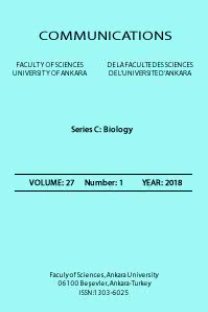POLLEN MORPHOLOGY OF SELECTED ALLERGENIC SPECIES AT BEŞEVLER 10. YEAR CAMPUS, ANKARA UNIVERSITY, TURKEY
allergy, plant, pollen, beekeeping, Beşevler 10.year campus, Ankara, Turkey
___
Sin, A. B., Pınar, N. M., Mısırlıgil, Z., Ceter, T., Yıldız, A., Alan, Ş., Polen Allerjisi (Türkiye Allerjik Bitkilerine Genel Bir Bakış), Engin Yayınevi, Ankara, 2007.AL-Sadoon, M. A., Muhbes, Z. S, Abdul-Mohsin, A. H, Adnan, M. A., Allergies and Their Effects on medical Students of Basra University.
Kalyoncu, A. F., Karakoca, Y., Demir, A.U., Alpar, R., Shehu, V., Cöplü, L., Sahin, A. A., Baris, Y. I., Prevalence of asthma and allergic diseases in Turkish university students in Ankara. Allergol Immunopath., 24 (4) (1996), 152–157.
Kalyoncu, A. F., Demir, A. U., Ozcakar, B., Bozkurt, B., Artvinli, M., Asthma and allergy in Turkish university students: Two cross-sectional surveys 5 years apart. Allergol Immunopath, 29 (6) (2001), 264–271.
Pinar, N. M., Akgül, G., Tuğ, G. N., Palinoloji Laboratuar Kılavuzu, Ankara, Ankara Üniversitesi Fen Fakültesi Döner Sermaye İşletmesi Yayınları, 2003.
Türkmen, Y., Ceter, T., Pinar N. M., Analysis of airborne pollen of Gümüşhane Province in northeastern Turkey and its relationship with meteorological parameters, Turk J Bot., 42 (6) (2018), 687–700.
Baldemir, A., Alan, Ş., Şahin, A. A., Paksoy, M. Y., Pınar, N. M., Pollen morphology of Scaligeria DC.(Apiaceae) in Turkey, Turk J Bot., 42 (4) (2018), 462–477.
Wodehouse, R. P., Pollen grains. Their Structure, Identification and Significance in Science and Medicine, The Journal of Nervous and Mental Disease, 86(1) (1937) 104.
Faegri, K., Iversen, J., Textbook of pollen analysis. Munksgaard, Copenhagen, 295 p. 1975.
Punt, W., Hoen, P. P., Blackmore, S., Nilsson, S., Le Thomas, A., Glossary of pollen and spore terminology, Rev Palaeobot Palyno., 143 (1–2) (2007), 1–81.
Punt, W., Blackmore, S., Nilsson, S., Le Thomas, A., Glossary of pollen and spore terminology: LPP Contributions series No. 1. International Federation of Palinological Societies, 71p, 1994.
Yun, Y. Y., Ko, S. H., Park, J. W., Hong, C. S., IgE immune response to Ginkgo biloba pollen, Ann Allergy Asthma Immunol., 85 (4) (2000), 298–302.
Pınar N. M., Urban landscape and pollen allergy. Commun. Fac. Sci. Univ. Ank. Series C., 27 (2) (2018), 120-125.
Singh, A. B., Allergy and Allergen Immunotherapy: New Mechanisms and Strategies, ISBN: 1-351-80034-5, CRC Press, 2017.
Weber, M, Ulrich, S., PalDat 3.0–second revision of the database, including a free online publication tool, Grana, 56 (4) (2017), 257–262.
Cruden, R. W., Pollen grains: why so many? Pollen and Pollination, Springer, (2000), 143–165.
Phelps, J., Headliners: Allergies: Ragweed Subpollen Particles Reach Deep into Lungs, ISBN: 0091-6765, National Institute of Environmental Health Sciences, 2007.
Taketomi, E. A., Sopelete, M. C., de Sousa Moreira, P. F., Vieira, F. D. A. M., Pollen allergic disease: pollens and its major allergens, Braz. J. Otorhinolaryngol., 72 (4) (2006), 562–567.
Dahl, A., Pollen lipids can play a role in allergic airway inflammation, Front Immunol., 9 (2018), 2816.
Suárez‐Cervera, M., Vega‐Maray, A., Castells, T., Rodriguez‐Rajo, F. J., Asturias, J. A., Le Thomas, A., Seoane‐Camba, J. A., An approach to the knowledge of pollen and allergen diversity through lipid transfer protein localisation in taxonomically distant pollen grains, Grana, 47 (4) (2008), 272–284.
Davis, G. L., Systematic embryology of the angiosperms, Systematic Embryology of the Angiosperms, 1967.
Vinckier, S., Smets, E., A survey of the presence and morphology of orbicules in European allergenic angiosperms. Background information for allergen research, Can J Bot., 79 (7) (2001), 757–766.
Vinckier, S., Smets, E., The potential role of orbicules as a vector of allergens, Allergy, 56 (12) (2001), 1129–1136.
Ruggiero, F., Bedini, G., Free orbicules of Cupressaceae detected in daily aerobiological samples by optical and confocal microscopy, Aerobiologia, 34 (1) (2018), 55–62.
Southwick, E. E., Loper, G. M., Sadwick, S. E., Nectar production, composition, energetics and pollinator attractiveness in spring flowers of western New York, Am J Bot., 68 (7) (1981), 994–1002.
Waser, N. M., Flower constancy: definition, cause, and measurement, Am Nat., 127 (5) (1986), 593–603.
Lau, P., Bryant, V., Ellis, J. D., Huang, Z.Y., Sullivan, J., Schmehl, D. R., Cabrera, A. R., Rangel, J., Seasonal variation of pollen collected by honey bees (Apis mellifera) in developed areas across four regions in the United States, Plos one, 14 (6) (2019), e0217294.
Sorkun, K., Türkiye’nin nektarlı bitkileri, polenleri ve balları, ISBN: 9944-341-67-3, Palme Yayıncılık, 2008.
Bousquet, J., Campos, J., Michel, F. B., Food intolerance to honey, Allergy, 39 (1) (1984), 73–75.
Helbling, A., Peter, C. H., Berchtold, E., Bogdanov, S., Müller, U., Allergy to honey: relation to pollen and honey bee allergy, Allergy, 47 (1) (1992), 41–49.
Dutau, G., Rance, F., Honey and honey-product allergies, Rev Fr Allergol., 49 (Suppl. 1) (2009).
- ISSN: 1303-6025
- Yayın Aralığı: Yılda 2 Sayı
- Başlangıç: 1943
- Yayıncı: Ankara Üniversitesi
Zeinab BARZOIE, Mohammad ARMİN, Hamid MARVİ
SYNOPSIS OF THE GENUS COTA (ANTHEMIDEAE, ASTERACEAE) IN TURKEY
Mehmet Ufuk ÖZBEK, Mecit VURAL
Gözde KÜÇÜK, Mehmet Uğur YILDIRIM
SEDIMENT-FRIENDLY FORMULAS: A REVIEW ON THE SEDIMENT QUALITY GUIDELINES
Aydan ACAR ŞAHİN, Nur Münevver PINAR
ALTHENIA ORIENTALIS (POTAMOGETONACEAE) IN TURKEY: HABITAT CONDITIONS, MORPHOLOGY AND ANATOMY
Necati BAYINDIR, Nursel İKİNCİ
Büşra YAZICILAR, Serap KARAMAN, İsmail BEZİRGANOGLU, Doğan İLHAN
INVESTIGATION OF FUNGI SPORES CONCENTRATION IN NIĞDE ATMOSPHERE (TURKEY)
Talip ÇETER, Esin BAYAR, Mohamed Nurı ELTAJOURI, Cemil İŞLEK, Nur Münevver PINAR
THE FISH FAUNA OF A KARST SPRING; ÖZLEN STREAM (ANTALYA, TURKEY)
